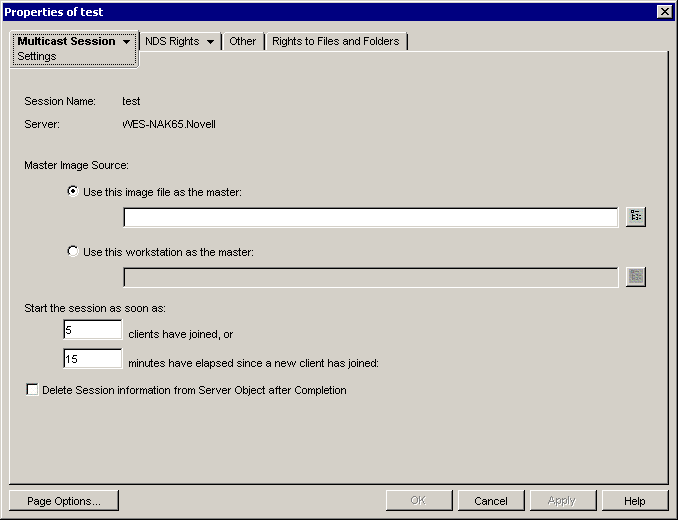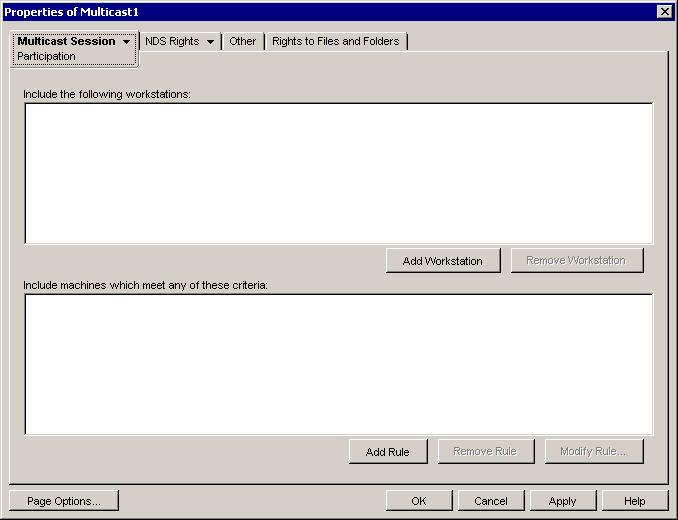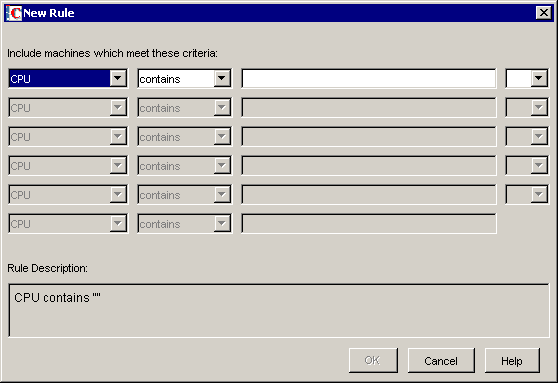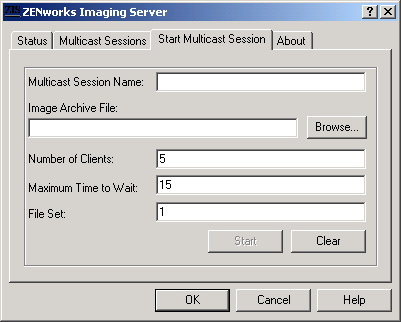Performing a Multicast Session
The following sections contain additional information:
Initiating an Automatic Multicast Session in ConsoleOne
When you initiate an automatic multicast session in ConsoleOne®, you do not need to start the session from the ZENworks Imaging server or physically visit each participating workstation. You name the session, define the master image source (an image file or workstation), and then add Workstation objects to include in the multicast session or define rules to include workstations that meet specific criteria you set.
To initiate an automatic multicast session in ConsoleOne:
-
(Optional) Install the Desktop Management Imaging Agent on each of the participating workstations.
IMPORTANT: If you do not install the Desktop Management Imaging Agent on each participating machine, those machines will have duplicate network identities. For more information, see Limitations of Multicasting Images.
-
In ConsoleOne, right-click the Server object, click Properties, then click the ZENworks Imaging tab.
If you do not see the ZENworks Imaging tab, click the right-arrow on the right side of the displayed tabs until it displays.

-
Click Add, type a name for the multicast session, then click OK.

-
Specify the Master Image Source.
You can specify an image file or a master workstation.
A workstation cannot be the master if it is being used as a master in another multicast session or if it explicitly participates in any other session.
-
Decide how many participating workstations you want to have booted up before the multicast session begins. Specify this number in the Clients Have Joined text box.
The default if you do not specify a number is 5 workstations.
-
If not enough workstations have booted up to fulfill the Clients Have Joined requirement, the multicast session will begin if a participating workstation boots up and a certain amount of time passes without another participating workstation booting up. Specify this amount of time in the Minutes Have Elapsed Since a New Client Has Joined text box.
The default if you do not specify a time is 15 minutes.
-
(Optional) To delete the session after it has finished, select the last check box.
-
Click the down-arrow on Multicast Session tab, then click Participation.

-
Click Add Workstation under Include the Following Workstations to explicitly add the workstation objects that you want to include in this multicast session.
or
To create rules to select the workstations you want to participate in this multicast session, click Add Rule under Include Machines Which Meet Any of These Criteria.

Click Help on the Participation page for more information.
-
Click OK to return to the ZENworks Imaging Multicast Sessions page.
-
The check box next to the multicast session name is automatically selected, showing that the session is enabled. If you want to disable a multicast session, deselect the check box next to the session name.
-
(Optional) If you want to change the position of a session in the list, select the multicast session name, then click Move Up or Move Down.
If multiple multicast sessions are defined that use rules to select participating workstations, it is possible that a workstation could qualify to participate in more than one session. If this occurs, the first enabled session in this list for which the workstation qualifies takes precedence over the other enabled sessions.
-
Click OK.
Performing a Manual Multicast Session
If you want to perform a manual multicast session, you need to start the multicast session from the ZENworks Imaging server (NetWare or Windows) and physically visit each participating workstation. Performing a manual multicast session is particularly useful in a lab environment in which a small number of workstations participate.
The following sections contain step-by-step information about performing a manual multicast session:
- Initiating a Multicast Session from the ZENworks Imaging Server
- Initiating a Multicast Session from Each Client
To perform a manual multicast session, you must perform the steps in both sections; however, the order in which you perform the tasks does not matter.
Initiating a Multicast Session from the ZENworks Imaging Server
You can use either a NetWare® or Windows ZENworks Imaging server to initiate a multicast session. The following sections contain additional information:
- Initiating a Multicast Session from a NetWare ZENworks Imaging Server
- Initiating a Multicast Session from a Windows ZENworks Imaging Server
Initiating a Multicast Session from a NetWare ZENworks Imaging Server
-
From the Netware server, load the ZENworks Imaging Server (imgserv.nlm).
-
From the Main Menu, select Manually Start Multicast.
-
Specify the path to the image archive.
You can either type the full path to the image file you want to use, or you can press Insert browse for the image file.
-
Specify the name for the multicast session.
-
Decide how many participating workstations you want to have booted up before the multicast session begins. Type this number in the Number of Clients field.
The default if you do not specify a number is 1 workstation.
-
If not enough workstations have booted up to fulfill the Number of Clients requirement, the multicast session begins if a participating workstation boots up and a certain amount of time passes without another participating workstation booting up. Specify this amount of time in the Maximum Time to Wait field.
The default if you do not specify a time is 5 minutes.
-
(Optional) Specify a file set.
-
Press Esc, then select Yes to start the multicast session.
-
(Conditional) If you have not done so, proceed with the steps under Initiating a Multicast Session from Each Client.
After you initiate the multicast session from each participating client, the image is sent to and put down on each participating workstation.
At the Main Menu, select Multicast Sessions to see how many clients have registered and how many the session is still waiting for. For example, 3/2 means 3 clients have registered and 2 more need to register before the session can begin. You can delete any session listed, even if it is in progress, by selecting the session name, then pressing Delete.
Initiating a Multicast Session from a Windows ZENworks Imaging Server
-
From the Windows taskbar, click the ZIS icon to start the ZENworks Imaging Server program.

-
Click the Start Multicast Session tab.

-
Type the name for the multicast session.
-
Browse to and specify the image archive file.
-
Decide how many participating workstations you want to have booted up before the multicast session begins. Specify this in the Number of Clients text box.
The default if you do not specify a number is 5 workstations.
-
If not enough workstations have booted up to fulfill the Number of Clients requirement, the multicast session begins if a participating workstation boots up and a certain amount of time passes without another participating workstation booting up. Specify this amount of time in the Maximum Time to Wait text box.
The default if you do not specify a time is 15 minutes.
-
(Optional) Specify a file set.
-
Click Start.
-
(Conditional) If you have not done so, proceed with the steps under Initiating a Multicast Session from Each Client.
You can click the Status tab to see how many Update Requests have been received, how many images have been sent or received, and the number of client referrals.
You can click the Multicast Sessions tab to view current multicast sessions. You can also delete any session listed, even if it is in progress, by selecting the session name, then clicking Delete. You can refresh a session by selecting the session name, then clicking Refresh.
Initiating a Multicast Session from Each Client
You can use the bash prompt or the ZENworks Imaging Engine menu to perform the multicast session as you physically visit each workstation.
The following sections contain additional information:
- Using the Bash Prompt to Perform the Multicast Session
- Using the ZENworks Imaging Engine Menu to Perform the Multicast Session
Using the Bash Prompt to Perform the Multicast Session
-
(Optional) Install the Desktop Management Imaging Agent on each of the participating workstations.
If you do not install the Desktop Management Imaging Agent on each participating machine, the machines will have duplicate network identities. For more information, see Limitations of Multicasting Images.
-
Create a set of imaging boot diskettes (SP1 only) or an imaging boot CD or DVD for each person who will assist with the multicast session, or enable PXE on the participating workstations.
If you don't know how to do this, see Preparing an Imaging Boot Method.
-
At each workstation, including the master workstation (unless you will be starting the multicast session from the imaging server), access a Linux prompt by using the imaging boot diskettes (SP1 only), imaging boot CD or DVD, or if it is PXE-enabled, boot it up.
-
Enter manual at the boot prompt.
-
To identify each participating workstation in the multicast session, enter the following command at the bash prompt of every workstation:
img session name
where name is any string that uniquely identifies this multicast session from other multicast sessions that might be in progress on the network. Use the same session name on each of the participating workstations in this multicast session. You can specify any multicast session, including one that originates from the Imaging server (as long as you specify the session name used by the Imaging server).
Example: img session doug
The img session command can take other parameters that allow you to designate the master workstation and the imaging start time beforehand. See Imaging Engine (Img: Command Line and Menu) for details.
-
(Conditional) If you have not already done so, start the multicast session from the master workstation or from the Imaging server.
Master Workstation: To start the multicast session from the master workstation, after all the other workstations have registered as participants, click Start Session.
If you start the session from the master workstation, the session master must be a workstation. If you start the session from the Imaging server, the session master must be a previously saved image file.
The Imaging engine begins creating the image of the master workstation and the image is sent to and put down on each participating workstation. Any problems are reported and displayed on the master workstation.
Imaging Server: To start the multicast session from the Imaging server, follow the steps under Initiating a Multicast Session from the ZENworks Imaging Server.
-
At each participating workstation, when the imaging is done, do the following to boot the workstation with the new operating system:
Using the ZENworks Imaging Engine Menu to Perform the Multicast Session
-
(Optional) Install the Desktop Management Imaging Agent on each of the participating workstations.
If you do not install the Desktop Management Imaging Agent on each participating machine, the machines will have duplicate network identities. For more information, see Limitations of Multicasting Images.
-
Create a set of imaging boot diskettes (SP1 only) or an imaging boot CD or DVD for each person who will assist with the multicast session, or enable PXE on the participating workstations.
If you don't know how to do this, see Preparing an Imaging Boot Method.
-
At each workstation, including the master workstation (unless you will be starting the multicast session from the imaging server), access a Linux prompt by using the imaging boot diskettes (SP1 only), imaging boot CD or DVD, or if it is PXE-enabled, boot it up.
-
Enter manual at the boot prompt.
or
Select Start ZENworks Imaging in Maintenance Mode from the PXE menu.
-
To identify each participating workstation in the multicast session, type img at the bash prompt to display the ZENworks Imaging Engine menu.
-
Click Imaging, then click Multicast Session.
-
Type a session name.
The session name is any string that uniquely identifies this multicast session from other multicast sessions that might be in progress on the network. Use the same session name on each of the participating workstations in this multicast session. You can specify any multicast session, including one that originates from the Imaging server (as long as you specify the session name used by the Imaging server).
-
Select a Session Role option:
Master: Select this option if this is the session master.
Client: Select this option if this is a participating workstation.
-
(Optional) If you chose Master in Step 8, specify any additional options:
Compression Level: Specify the compression level you want to use for this multicast session:
None: No data compression is used. Data is sent immediately across the network to participating workstations. You might use this option if the master workstation has a slow CPU; the amount of time to compress the data is eliminated and the data is immediately sent across the network. Using this option, however, the multicast session creates more network traffic than it would if you selected one of the other compression levels (Speed, Balanced, or Size).
Speed: Takes the least amount of time to compress the data before the data is sent across the network to participating workstations. You might use this option if the master workstation has a slow CPU; the amount of time to compress the data is reduced before the data is sent across the network. With this option, however, the multicast session creates more network traffic than it would if you selected either the Balanced or Size compression level.
Balanced: Represents a compromise between data compression and the amount of network traffic that the multicast session creates.
Size: Takes the most amount of time to compress the data before sending it across the network to participating workstations. You might use this option if the master workstation has a fast CPU. Using this option requires the most CPU resources to compress the data but creates less network traffic to transfer the data to the participating workstations.
Automated Session: Click Enabled to specify the number of participating workstations (clients) that must register before starting the automated multicast session and to specify the amount of time, in minutes, that can expire without the number of participating workstations to register before starting the automated multicast session. If you do not click the Enabled check box, you must manually start the multicast session.
-
Click Next, then click Start Session.
-
At each participating workstation, when the imaging is done, do the following to boot the workstation with the new operating system: